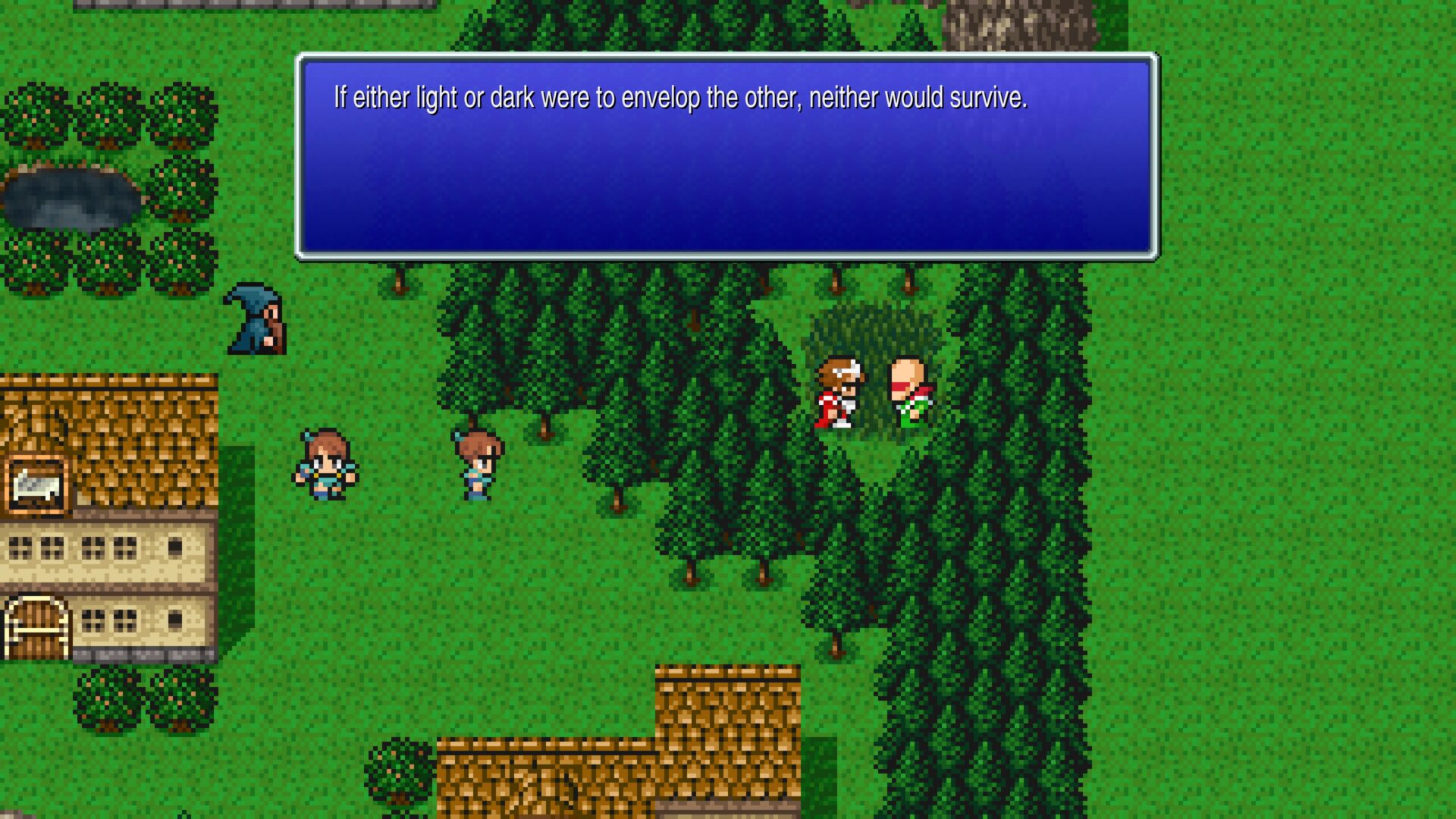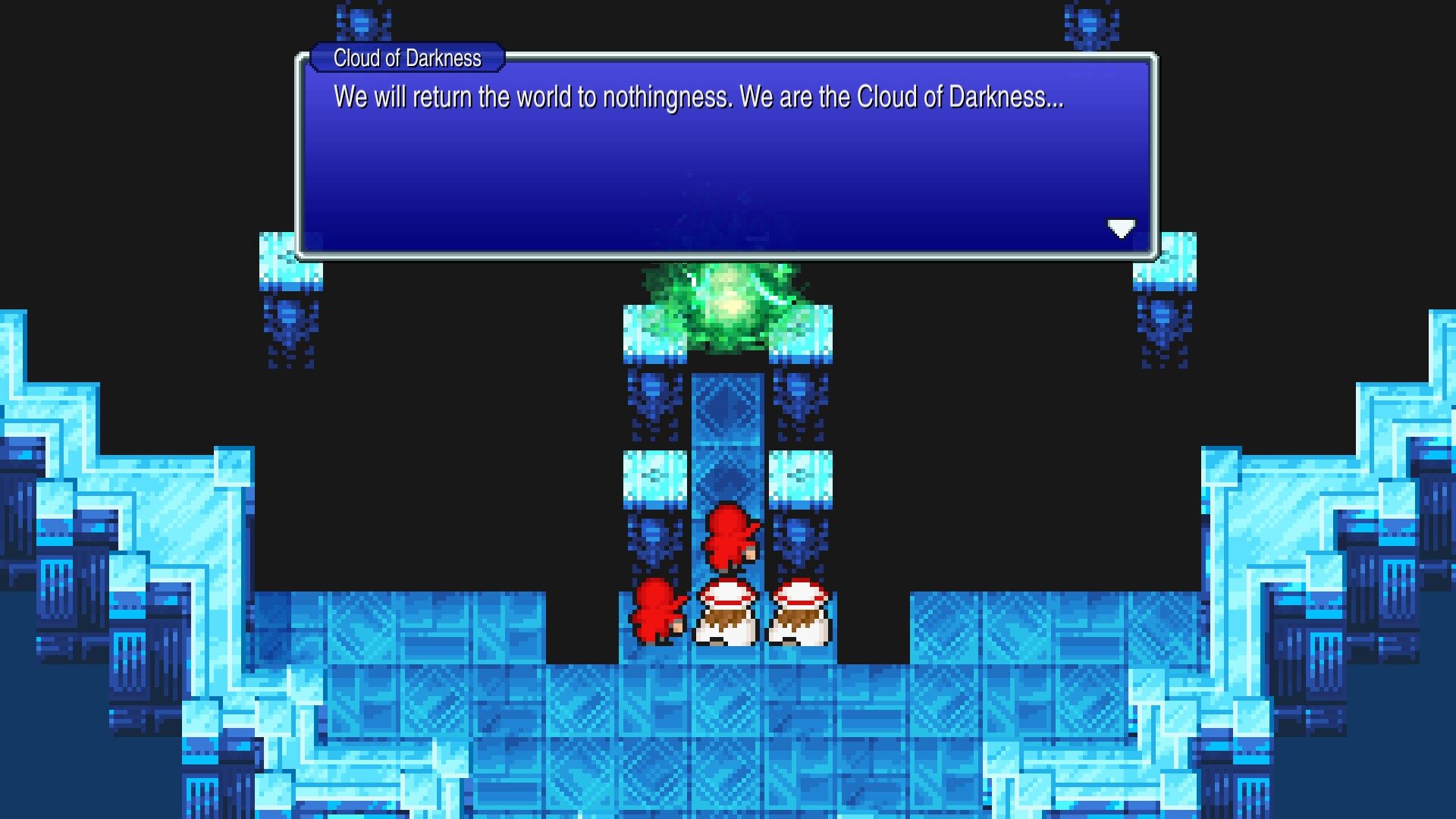
In our third entry of the Terminal Typology series, we’ll discuss various Christian themes present within Final Fantasy III. Such an exploration is not possible without discussing details of the story, so spoilers will abound. Please note it’s not so much our contention that the themes are present intentionally, but rather because the Final Fantasy games are good, contain truth, and are beautiful – and those transcendents can lead us to God. Essentially, we hope to nerd out over Final Fantasy III and follow these words of St. Augustine:
“…when anything pleases us because of You, You are what pleases us in that thing, and when by Your Spirit something pleases us, it pleases You in us.” (Confessions, Book 13, XXXI).
(Follow these links for the first and second entries in the series.)
Return of the Crystals
In this installment, we’re going to take a slightly different approach. Final Fantasy III represents a departure from the more character-focused Final Fantasy II, and a return to much of the imagery of the original. As such, there’s not necessarily new ground to tread when discussing specific motifs like the elemental crystals or the nameless heroes who seek to restore them. However, Final Fantasy III‘s more expansive worldbuilding breaks new thematic ground for the series, and can be interpreted in a few different ways. Before we can get there, though, a story summary is in order.
The world stands on the brink of calamity after a catastrophic earthquake weakens the four elemental Crystals of Light which both represent and maintain that world’s order. As their power fades, monsters begin to roam the world, and a nameless entity of darkness approaches, threatening to bring the world to nothingness. At the outset of the game, the player characters, four youths exploring the land around their hometown, fall into a cave. Inside, they happen upon one of the four waning crystals, the Wind Crystal. The Wind Crystal chooses the youths as its champions, bestows its remaining light upon them, and tasks them with restoring balance to the world.

When in the course of their quest they meet the hidden Ancients, the youths discover they are part of a plan larger than they could have known. Their World of Light is paired with a World of Darkness, both of which are governed by living forces and have their own quartet of crystals. These worlds faced a similar existential threat a thousand years in the past, when the humans at that time abused the power of the crystals and caused the “Wrath of Light”. When the Ancients unwittingly unleashed a flood of uncontrollable destructive power, both the Light and Dark Crystals chose heroes to restore balance and thus save their worlds.
We eventually learn that the threat in the present stems from the spiteful wizard Xande. Long ago, Xande was one of three students of the world’s greatest mage, Noah. Before his passing, Noah bequeathed unique gifts to each of his students. While the other two students, Doga and Unei, received gifts governing magic and dreams, Xande received mortality. Xande resented this gesture and resolved to destroy the world by tipping the balance between the crystals and thus summon the approaching “Cloud of Darkness”. By twisting the power of the Earth crystal to his ends, Xande triggers the earthquake that sets the events of the game in motion.
To fulfill their destiny as the Warriors of Light, and to prepare for a confrontation with Xande, the youths search their world for the remaining elemental Crystals. Along the way, they are aided by Xande’s erstwhile peers, Doga and Unei, who help guide and equip the heroes for the final battle. Once they obtain the power of each Crystal of Light, the heroes infiltrate Xande’s lair and defeat him, but not before the Cloud of Darkness is summoned. In a bid to finally save their world from fading into oblivion, the heroes travel to the World of Darkness where they can join with the Warriors of Darkness to combat the Cloud of Darkness. (Lots of darkness to be had.) Together, they dispel the formless evil entity and ensure the worlds’ crystals will be restored.
Final Fantasy III‘s proposition of a balance between Light and Darkness as the ultimate goal may be off-putting, since we as Christians are not interested in fostering a balance between cosmic forces of good and evil. As John reminds us, “God is light, and in him there is no darkness at all” (1 Jn 1:5). However, I think it can be helpful to resist immediately mapping what a given story calls “Light” and “Dark” to “Good” and “Evil”. Scripture is replete with figures who assume mantles of goodness that mask corrupted cores. Similarly, a story written from a purely secular perspective might cast the Church as a force of darkness. Darkness can also be used as symbolic of a proper acknowledgment that God must be our guiding light, rather than one of our own making, as we see in Isaiah 50:10. The concept of balance, then, need not be taken as an eternal truce between good and evil.

“But Spicy,” you say, “Final Fantasy III still has similarities to Manichean ideas, and we should therefore dismiss this tale as flirtatious with such.” There are indeed certain commonalities with Manichaeism, but I think dismissing the game outright would be a mistake, and not just because you’d miss out on a satisfying classic JRPG. Yes, the Manicheans held that there was a kingdom of dark as well as light governed by the devil and God respectively, which they proposed were deities of equivalent power. Similarly, Final Fantasy III has Light and Dark as living forces governing separate worlds, but there is a distinction that can be made that elevates Final Fantasy III over the Manicheans.
The Manicheans’ dualistic system placed the Kingdoms of Light and Darkness in opposition. Light was associated with God, spirit, and goodness, while Dark was associated with the devil, matter, and evil. This theological error was used to justify all manner of sinful behaviors, because as composites of evil material and good spirit, humans could not be held responsible for what they did. If one’s body is under the influence of an evil deity as powerful as God, how can one be expected to resist?
If we read Final Fantasy III carefully, we see that its worlds of Light and Dark do not equate to the Manichean kingdoms. They’re not in opposition, and the World of Darkness is never portrayed as evil – in fact it is shown to be instrumental in saving creation in both the past and the present. The two worlds are more akin to geographically distinct regions within the same universe, up against an enemy who would prefer that they both be destroyed. The aim of the game’s ultimate evil – the “Cloud of Darkness” – is to bring both worlds to non-being. Therefore, unlike the Manicheans, material creation is considered good, and something both worlds have a share in preserving. Even if it is obscured by naming conventions, Final Fantasy III avoids asserting an erroneous Manichean cosmology. (Or at the very least, allows for that interpretation.)

With the understanding that Final Fantasy III‘s worlds are not intended to be allegorical of good and evil, I propose a positive interpretation of the game in terms of the moral life, in which we might identify not with any particular character but with the world itself.
Not Turning Right or Left
While we are not called to bring about a balance between good and evil, we are called to be attentive to and follow God’s will, which could be likened to being a marble balancing on the tip of an egg. Any deviation from that point, regardless of its direction, causes it to fall, and so it is with us, which is why scripture often reminds us not to stray right or left:
“You shall be careful to do therefore as the Lord your God has commanded you; you shall not turn aside to the right hand or to the left.” Deut 5:32
“Only be strong and very courageous, being careful to do according to all the law which Moses my servant commanded you; turn not from it to the right hand or to the left, that you may have good success wherever you go.” Josh 1:7
Fortunately for us, we are loved by an infinitely merciful God who is always willing to bring us back up.
Furthermore, we are called to practice virtue, which requires us to observe balances between extremes. For example, we would want to practice prudence in order to achieve worthy goals effectively and practically, but not necessarily operate with so much caution that we fail to take the risks that cooperation with God’s grace might require. St. Thomas elaborates on this concept in the Summa:
“But the good of that which is measured or ruled consists in its conformity with its rule; thus the good of things made by art is that they follow the rule of art. Consequently, in things of this sort evil consists in discordance from their rule or measure. Now this may happen either by exceeding the measure or by their falling short of it…between excess and deficiency the mean is equality or conformity. Therefore it is evident that moral virtue observes the mean.” (Question LXIV, Article 1)
I would contend that we often give ourselves license to practice one of these excesses or deficiencies by rationalizing one as virtuous and casting the other as sinful. The correct balance – the alignment with God’s will that we must seek – can only be achieved through attentiveness to His will over our own, and it is that sense of balance I see analogized in the quest to restore the crystals in Final Fantasy III.
In Final Fantasy III, we might be playing the role of the valiant heroes, but I see us as more typified by the world in danger. When we recognize that we have strayed, we must humble ourselves and be open to God’s grace, so He can be our champion and restorer.
Further Reading
The information above on the Manicheans was pulled largely from supplementary material in the Sheed translation of St. Augustine’s Confessions, volume 84 of Catholic University of America Press’s The Fathers of the Church series which collects St. Augustine’s books on Genesis against the Manichees, and Hilaire Belloc’s The Great Heresies. If you’re interested in learning more, the summary in Confessions is probably the most succinct, and you can use all that saved time to read the Confessions!
